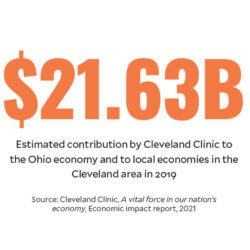December 6, 2022

A Taxing Opportunity for Brave Nonprofit Health Systems
Smart nonprofit health systems should pay their local, state and federal taxes as though they were for-profit companies.
You did just read that. I contend that it makes business sense for leading nonprofit health systems to pony up and pay taxes. In the long run, health systems that start paying taxes will create a new narrative, operate more efficiently, allocate resources more effectively and deliver higher value to their communities.
This suggestion is a nonstarter or worse at most nonprofit health systems. It’s a fantastic conversation ender. C-suite executives can’t get away fast enough. They leave skid marks. Bear with me. There’s a method to my madness. It begins with a story about The Cleveland Clinic from 2017.
No Good Deed Goes Unpunished
Dan Diamond with The Washington Post is among the nation’s leading investigative journalists. On July 17, 2017, while at Politico, Diamond released two massive investigative reports. Each examined the relationship between leading academic medical centers (AMCs) and their surrounding communities.
The first article, “How Hospitals Got Richer off Obamacare,” details how U.S. News and World Reports’ top-ranked AMCs (UCLA Health, Cleveland Clinic, UCSF Health, Massachusetts General Hospital, Mayo Clinic, Johns Hopkins Hospital and New York-Presbyterian) fended off challenges to their tax-exempt status and boosted revenues while cutting charity care.
The combined revenue for the seven institutions increased by 15% ($4.5 billion) between 2013 and 2015. During the same period, their combined charity care dropped by 35% from $414 million to $272 million. In aggregate, these acclaimed institutions spent less than 2% of their revenues on charity care during this period.
Beyond numbers, Diamond describes a “bizarre contrast” in many cities that “boast hospitals that are among the best in the world, but the communities around those hospitals might as well be the Third World.” His second article, “How the Cleveland Clinic Grows Healthier While Its Neighbors Stay Sick,” explores this contrast through the lens of the impoverished neighborhoods surrounding the Clinic’s main campus east of downtown Cleveland.
Diamond’s implicit bias is that America’s leading AMCs must do more than deliver world-class clinical care, conduct pathbreaking medical research and train the next generation’s best physicians. For Diamond, location is destiny. He opines that AMCs, like the Cleveland Clinic, must do more for their struggling communities. They should invest actively in urban renewal, workforce empowerment and community development. Diamond’s demands, while understandable, are unrealistic.
Correlation is Not Causation
At 32.7%, Cleveland’s poverty rate in 2021 was the nation’s second highest behind Detroit. By accident of history, the Cleveland Clinic’s main campus is adjacent to several impoverished neighborhoods. From there, the Clinic operates one of the world’s most advanced medical enterprises. It is Ohio’s largest employer and generates over $20 billion in direct and indirect economic value each year for the state. Imagine Cleveland without the Clinic.
As a healthcare provider, the Clinic is not expert in population health nor urban revitalization. Expecting otherwise is ludicrous. Despite this, the Clinic has undertaken several initiatives to enhance the health and well-being of its local communities. The Clinic’s online Community Benefit page states that these contributions include “providing free or discounted medically necessary care and clinical services, working to improve public health, educating medical professionals and conducting research to fight disease.”
Still, internal and external demands for Clinic resources grow larger and louder. By contrast, no reporters write investigative reports about the community benefit offered by large for-profit health systems like HCA Healthcare in Nashville, Tennessee. At what point does it simply become easier for the Cleveland Clinic and other leading nonprofit health systems to pay taxes, reduce external interference and manage their organizations with greater autonomy?
Is the Tax-Exempt Juice Worth the Societal Squeeze?
Like for-profit hospitals, nonprofit hospitals must generate positive margins to sustain their operations. Some do this very well. A 2016 analysis in Health Affairs found that seven of the nation’s 10 most-profitable hospitals are tax-exempt organizations.1
Here’s the rub. Granting tax-exemption to hospitals carries a high cost. A recent article in The Wall Street Journal made this point through its title, “Big Hospitals Provide Skimpy Charity Care — Despite Billions in Tax Breaks.” The Journal article also cited work by Gerard Anderson, one of the authors of the 2016 Health Affairs article, in which he pegs the annual societal cost of hospital tax exemption at $60 billion.
 As these reports demonstrate, tax exemption comes with strings. Whether the benefits to society of granting hospitals tax exemption are greater than their costs is a debate for another day. I’m interested in the reciprocal question: Have the costs of tax exemption become too high for some leading nonprofit health systems to bear?
As these reports demonstrate, tax exemption comes with strings. Whether the benefits to society of granting hospitals tax exemption are greater than their costs is a debate for another day. I’m interested in the reciprocal question: Have the costs of tax exemption become too high for some leading nonprofit health systems to bear?
Almost all nonprofit health systems operate centralized, bureaucratic and high-cost delivery platforms that resist value-based care delivery, consumerism and innovative new business models. Too many cling to volume-based, transactional and fee-for-service medicine. Those doing so are at risk of losing market relevance.
In today’s dynamic and disruptive healthcare marketplace, health systems that wish to survive must become outcomes-focused, vertically integrated, asset-light, customer-centric and risk-based operators. Yet attempts by nonprofit systems to streamline operations, close service lines and/or fund nontraditional investments almost always encounter forceful opposition. It’s often easier not to rock the boat, but accommodation leads to suboptimal resource allocation and subpar operating performance.
The costs that accompany tax exemption have become too high for many leading nonprofit health systems. Greater organizational flexibility is the principal reason that for-profit health systems have outperformed nonprofit systems during COVID and its aftermath. Paying taxes voluntarily would reduce external scrutiny and increase operating and strategic flexibility. In doing so, nonprofit health systems could move faster and more aggressively to implement cutting-edge technologies, redesign business models and cut costs.
What If…
Let’s be clear. I am not suggesting nonprofit health systems should convert to for-profit status. What I am suggesting is that paying taxes would enable nonprofit health systems to become more efficient operators and increase the amount of community benefit they provide.
While the financial burden of paying taxes would initially be high, most leading nonprofit health systems have sufficient cash reserves to fund any related short-term operating losses. Paying taxes voluntarily would yield the following benefits:
- Community Goodwill. It would engender enormous goodwill with state and local leaders. They would do cartwheels at the prospect of increased tax receipts.
- First-Mover Advantage. It would put enormous political and operating pressure on competing nonprofit systems to also pay taxes.
- Operating Flexibility. Management would have greater freedom to pursue continuous performance improvement.
- New Narrative. Instead of constant complaints about greedy nonprofits, media will bestow lavish praise on health systems that support their communities by paying taxes.
- Strategic Flexibility. Health systems could aggressively pursue partnerships, migrate routine care delivery to lower-cost venues and invest in new business models.
- Implementation Flexibility. Health systems could gradually phase in their contributions and/or invest hypothetical federal taxes in “health multiplier” programs.
Uncle Sam needs a few brave nonprofit health systems to volunteer for this mission. The benefits that accrue to these tax-paying volunteers are significant and potentially transformational. The brave health systems that take the plunge will become more competitive. They will win hearts and minds. They will lead a broken industry out of the wilderness.
To nonprofit health systems, I have this advice: Dare to be great. Your country needs you.
—This article first appeared as a column on the HFMA website.





